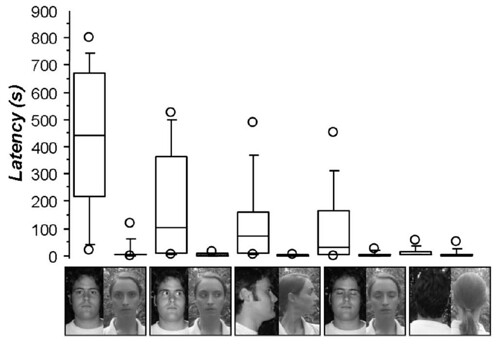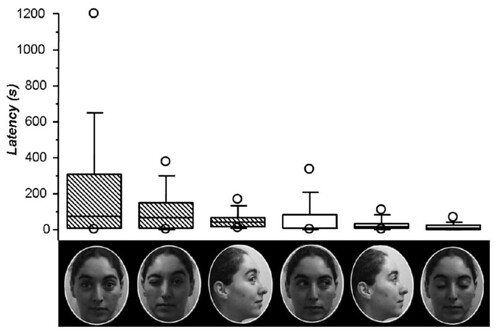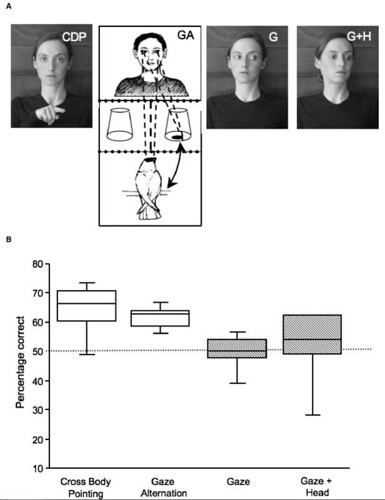tags: Eurasian Jackdaw, Corvus monedula, body language, behavior, peer-reviewed paper
Eurasian Jackdaw, Corvus monedula.
This is the smallest species of corvid (crows and ravens).
Image: Wikipedia [larger view].
Those of you who go birding will know what I am talking about when I say that birds are so capable of reading human body language that they know when we are looking at them, which frequently causes them to hide from our gaze. However, this capacity has never before been scientifically studied in birds, until now, that is.
A newly published paper studied handraised, tame Eurasian Jackdaws, Corvus monedula, a small relative of the crows. Jackdaws' eyes have a dark pupil surrounded by a striking silvery iris -- similar to human eyes.
"I think they can generalize to human eyes somehow, and interpret human eyes as eyes," explained Auguste von Bayern, lead author on the paper, formerly of the University of Cambridge and now located at the University of Oxford.
Because these birds were handfed and were therefore very familiar with people, the researchers believe these birds were even more capable of interpreting human gaze and body language than their wild counterparts.
"Jackdaws seem to recognize the eye's role in visual perception, or at the very least they are extremely sensitive to the way that human eyes are oriented," she continued.
To test the birds ability to interpret human gaze, ten hand-raised jackdaws were placed into a threatening situation where a preferred food item -- the "reward" -- was presented to them while in the presence of a human. The threatening situation was the result of being in the presence of a person who was a stranger to the birds and comparing the birds' reactions to a stranger to their reactions when in the presence of a person who was familiar to them (figure 1);
Figure 1. The Jackdaws' Response to Five Different Attentional States Displayed by an Unfamiliar and a Familiar Human
Box plots displaying median latency (s) to retrieve the food in the presence of an unfamiliar (white box plots) and a familiar (shaded box plots) human displaying different attentional states (B, C, G, P, or F). Whiskers designate the 90% and 10% confidence intervals. Open circles denote outliers. [larger view].
These data show that the birds took longer to retrieve the reward when the stranger was looking toward the food item than when they were looking away from it.
To determine the jackdaws' response to more subtle attentional cues and to control for any potentially unwanted behavioral cues by the human, the team then tested the jackdaws using a series of digital photographs of a different stranger's face that displayed several attentional states (figure 2);
Figure 2. The Jackdaws' Response to Six Digitally Presented Attentional States of an Unfamiliar Human's Face
Box plots displaying median latency (s) to take the food in the presence of an unfamiliar person displaying different attentional states (F, O, PG, G, P, and C) presented on a TFT monitor. Whiskers designate the 90% and 10% confidence intervals. Open circles denote outliers. The hatched boxes denote the ''attention toward'' conditions, whereas the white boxes designate the ''attention away'' conditions. [larger view].
They found that, independent of the person's facial orientation in the image, the number of visible eyes, or the perceptual similarity or dissimilarity of the stranger's attentional states, the time until the birds approach towards the food item depended on whether the human's eye(s) were oriented toward the food reward.
Because Jackdaws are cooperative species where members of a pair will share actively direct each others' attention to particular objects, the researchers then tested whether they would respond to a cooperative task with a human partner. To do this, the researchers baited one of two identical opaque chambers with a food reward. To determine if the Jackdaws were reading eye gaze or body language preferentially in a cooperative task, the human partner provided one of four distinct social cues to the birds; either gazing at the baited chamber without turning her head (G) or turning her head towards the baited chamber while gazing at it (G + H), and two body language cues; first where the stranger alternated her gaze repeatedly between the subject and the baited container (GA), or pointing at the baited chamber with her finger (CBP) (figure 3);
Figure 3. The Jackdaws' Responses to Human Communicative and Attentional Cues in an Object Choice Task
(A) Photographs of four social cues used in experiment 3 (CDP, GA, H, and G). (B) Box plots displaying the median percentage correct performance in choosing the box containing the hidden food across the four conditions; communicative cues (CDP and GA) are designated by white boxes and attentional cues (G + H) are designated by hatched boxes. Whiskers designate the 90% and 10% confidence intervals. [larger view].
According these data, the birds successfully interpreted human communicative gestures, such as gaze alternation and pointing, to help them find hidden food. However, the birds were unsuccessful in using static cues, including eye gaze or head orientation in this experiment.
Their skittish response to strangers may reflect an evolved response to potential predators or other threats, when subtle eye cues are less important than head orientation, Bayern wrote. Predatory birds such as owls and goshawks turn their entire head when looking at a prey animal, although, by that time, it's probably too late for Jackdaws to successfully react to a predator's subtler eye movements, even if they are close enough to see them.
These findings are especially interesting because most other species investigated so far, including chimpanzees and dogs, are not very sensitive to eye orientation and eye gaze, von Bayern pointed out. Rather, she wrote, chimps and dogs seem to rely on other cues such as head or body orientation in determining the looking direction of others but don't appear to appreciate the eyes as the visual organs.
"As it looks now, apes are surprisingly bad at looking at eyes, because it seems like other cues such as head direction are much more important [to them]," Bayern said. "But I think they understand a bit."
This supports the theory that social sophistication may select for intelligence in evolution, Bayern said. Jackdaws are corvids, which are among the most intelligent groups of birds along with parrots.These results suggest that birds may deserve more respect for their mental abilities.
"We may have underestimated the psychological realms of birds," von Bayern remarked. "Jackdaws, amongst many other birds, form pair bonds for life and need to closely coordinate and collaborate with their partner, which requires an efficient way of communicating and sensitivity to their partner's perspective."
Source:
Auguste M.P. von Bayern & Nathan J. Emery (2009). Jackdaws Respond to Human Attentional States and Communicative Cues in Different Contexts. Current Biology, 19 (7) DOI: 10.1016/j.cub.2009.02.062 [free PDF].





Wow, super interesting!
Owls don't have much in the way of subtler eye movements, AFAIK; they can blink and squint, of course, but they have very little ability to rotate their eyeballs. (Apparently the eyeball is highly non-spherical, and there also isn't much room in the socket for attached muscles.)
I suspect that they've developed gaze-sensitivity mostly for interacting (thieving, and avoiding attacks while foraging on the ground) with mammals.
Wild crows are certainly very good at this. I've done a little recording and field observation of them, and they watch you very very carefully to make sure you're not watching them. You can toss out some peanuts, and they'll come right down and start grabbing them even if there's a dozen people nearby...as long as all those people keep walking and ignoring them. If somebody stops, they get skittish, but it's okay as long as she's tying her shoe or carefully studying something in the opposite direction. But if she actually stops and looks at them, they pop back into the trees.
A lot of the marked crows in Ithaca nest on golf courses. The Ithaca Crow Project researchers often bring along an umbrella or something else club-shaped, and pretend to putt while they make observations! It really does soothe the birds' suspicions.
I wonder if songbird species which aren't as gaze-sensitive pick up on cues provided by other, cannier species? Another perk of those antipredator guilds, maybe....
I believe one of the coauthors of this study, Emery, worked with Nicky Clayton in Cambridge on her studies of behaviour in scrub jays. From this I am convinced that many corvids have a theory-of-mind and are much more intelligent than many mammals, including primates. It's funny how neuroscientists don't seem to appreciate this and cleave to a relentlessly linear view of the evolution of intelligence that culminates with human beings and ignores everything else.
There are about a bajillion jackdaws on the campus where I work, and I can add purely anecdotal support to the idea that they understand the issue of "directional gaze". They are always on the lookout for people eating outside in nice weather -- and as soon as you look away from whatever bits of your lunch that you are not actually holding, they are straight in there. It certainly isn't an accident, they are very good at it.
I've seen that behavior of crows on campus as well. When people are having a picnic, and look at them, they pretend to look for worms and stuff in the grass. As soon as the people turn away, they bounce/hop in and grab some crumbs or crust from the edge of a plate before flying away if successful, or flapping away if unsuccessful.
Under the photo, you've written that jackdaws are the smallest corvid. I always thought that jays and magpies were corvids as well. Am I wrong, or is this a question of semantics?